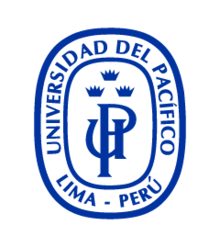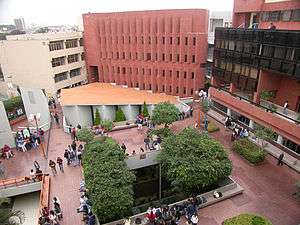Universidad del Pacífico (Peru)
Universidad del Pacifico (UP) is a private university in the Jesús María District of Lima, Peru.[1] It was established in 1962 by a group of Peruvian entrepreneurs supported by the Society of Jesus.[2] Ranked as the most prestigious higher education institution in its fields of specialization in Peru, it’s also one of the leading institutions of its kind in Latin American and is the first Peruvian university to be AACSB accredited in both undergraduate and graduate degree programs. It’s also AMBA accredited.
 | |
Other name | UP |
|---|---|
| Motto | Formamos líderes responsables para el mundo |
Motto in English | Forming responsible leaders for the world |
| Type | Private |
| Established | February 28, 1962 |
Religious affiliation | Jesuit (Roman Catholic) |
| Rector | Felipe Portocarrero Suárez |
| Students | 5,000 approx. |
| Address | Av. Salaverry 2020, Jesús María , , |
| Campus | Urban |
| Colors | Blue |
| Affiliations | SEKN, Laurin, AACSB, AAMBA, Consorcio de Universidades |
| Website | www.up.edu.pe |
Administration
The Society of Jesus co-founded the university and made the administrative and academic decisions necessary to establish it. Jesuits continue to make strategic decisions for UP, which is a member of the Association of Universities Entrusted to the Society of Jesus in Latin America – twenty-eight universities in fifteen countries of Latin America. The Society of Jesus together with the Board ensures compliance with principles behind the Universidad del Pacifico statutes.[3]
Academics
The University specializes in Business Management and Economics.[4]
At the undergraduate level, UP offers bachelor's degrees in Economics, Business Administration and Accounting. In 2008, it became the first university in Peru to offer a management Engineering degree. That same year, Law was added to its degree programs.[5] In 2011 two new departments were opened, International Business and Marketing.[6] At the graduate level, it offers a Master of Business Administration,[7] a Master of Finance and a Master of Economics.[8] In August 2011, the University as well as its Post-Graduate school received the AACSB (Association to Advance Collegiate School of Business) accreditation.
UP has approximately 5000 students enrolled.[9] The academic year at the undergraduate level consists of two semesters, from late-March to July and mid-August to mid-December, with a 3 to 4 week break between. At the graduate level the academic year consists of three terms: January–April, May–August, and September–December. UP cooperates with other agencies to provide service-learning courses.[4]
Research projects
The University, through the Research Center of the University (Centro de Investigación de la Universidad del Pacífico), conducts large-scale research projects within Peru and at the Latin American level, in matters of economic theory and trade, public policy, fiscal policy, environmental issues, human development, civil society, philanthropy, and SMEs development.[10] Some of these are funded by the Kellogg Foundation,[11] the World Bank, the Inter-American Development Bank, and other regional development agencies.
Notable alumni

- Mercedes Aráoz - Former Peruvian minister of finance. Elected 2nd Vice President of Peru.
- Martín Pérez Monteverde - Peruvian politician.
- Hernán Garrido Lecca - Peruvian economist and politician.
- Renzo Rossini - General manager of the BCRP.
- Raúl Diez Canseco Terry - Peruvian politician and economist.
- Julio Velarde Flores - President of the BCRP.
- Susana de la Puente Wiese - Ambassador from the Republic of Peru to the Court of St. James's.
- Walter Bayly - COO of Credicorp Ltd. and CEO of Banco de Crédito del Perú.
- Jorge González Izquierdo - Peruvian minister of Foreign Relations.
- Carlos Boloña Behr - Politician and president of the Free Trade Institute (IELM).
- Fernando Olivera Vega - Politician, ex-ambassador to Spain and former congressman.
- Eduardo Ferreyros Küppers - Politician, ex-minister of external commerce and tourism.
References
- "Universidad del Pacifico | Ranking & Review". www.4icu.org. Retrieved 2017-10-01.
- "Las mejores universidades del Peru". America Economia. Retrieved 1 September 2011.
- "La universidad | Universidad del Pacífico". Universidad del Pacífico (in Spanish). Retrieved 2017-10-01.
- "UBELONG partners with Universidad del Pacifico for program in Peru". UBELONG. 2013-03-11. Retrieved 2017-10-01.
- "Interview with the vice-dean of the Law School".
- International business and marketing. Accessed 3 June 2016.
- "Google Translate". translate.google.com. Retrieved 2017-10-01.
- "Study at Universidad del Pacifico, Lima - Peru". GoAbroad.com. Retrieved 2017-10-01.
- "Peru: Universidad del Pacífico". Tilburg University. Retrieved 2017-10-01.
- "Eldis". www.eldis.org. Retrieved 2017-10-01.
- "Kellog Foundation grants". Kellog Foundation grants.